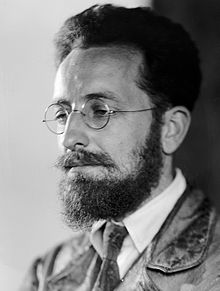Charles Seeger
Charles Seeger | |
|---|---|
 Charles Seeger | |
| Background information | |
| Birth name | Charles Louis Seeger Jr. |
| Born | December 14, 1886 Mexico City, Mexico |
| Died | February 7, 1979 (aged 92) Bridgewater, Connecticut, U.S. |
| Occupation(s) |
|
Charles Louis Seeger Jr. (December 14, 1886 – February 7, 1979) was an American
Life and career
Seeger was born in Mexico City, Mexico, to American parents Elsie Simmons (née Adams) and
Among Seeger's many specific interests were prescriptive and descriptive music writing[3] and determining the definition of what is meant by singing style.[4]
Along with composer Henry Cowell, ethnomusicologist George Herzog, Helen Heffron Roberts and Dorothy Lawton of the New York Public Library, Seeger was a founding member of the American Society for Comparative Musicology in 1933, the parent organization of the American Library of Musicology (ALM). Seeger envisioned the short-lived ALM as a publisher of music-related resources, but it ceased to exist by 1936.[5][6]
In 1936, he was in Washington, DC, working as a technical advisor to the Music Unit of the Special Skills Division of the
Seeger died on February 7, 1979, in Bridgewater, Connecticut. He was buried at the Springfield Cemetery in Springfield, Massachusetts along with his second wife.
Family

His first wife was Constance de Clyver Edson, a classical violinist and teacher; they divorced in 1927.[8] They had three sons, Charles III (1912–2002), who was an astronomer,[9] John (1914–2010), an educator,[citation needed] and Pete (1919–2014), a folk singer.
His second wife was the composer and musician
Contributions
He is known, among other reasons, for his formulation of
References
- ^ "Alan Seeger". Poetry Foundation. Retrieved May 8, 2019.
- ^ Capaldi, Jim, "Folk Scene: Charles Seeger" Archived May 17, 2006, at the Wayback Machine obituary April 1979
- ^ Seeger, Charles (April 1958). "Prescriptive and Descriptive Music Writing". The Musical Quarterly. pp. 184–195.
- ^ Seeger, Charles (1958). "Singing Style". Western Folklore. pp. 3–12.
- ISBN 0-8229-3713-1.
- JSTOR 852171.
- ^ Stone, Peter, Sidney and Henry Cowell, Archived August 19, 2016, at the Wayback Machine Association for Cultural Equity
- ^ New York Times, December 19, 1911 wedding announcement.
- ^ a b Obituary: Charles Seeger III, San Francisco Chronicle, 14 September 2002. Retrieved on May 2, 2009.
- ^ "Anthony Seeger Bio". UCLA Herb Alpert School of Music, Department of Ethnomusicology. Archived from the original on October 7, 2017. Retrieved October 6, 2017.
- ^ Spilker, John D., "Substituting a New Order": Dissonant Counterpoint, Henry Cowell, and the network of ultra-modern composers Archived August 15, 2011, at the Wayback Machine, PhD dissertation, Florida State University, 2010.
- ^ Bell Yung and Helen Rees, eds., Understanding Charles Seeger, Pioneer in Musicology (University of Illinois Press, 1999). (publisher's page on the book Archived October 18, 2004, at the Wayback Machine)
Further reading
- Pescatello, Ann M.,"Charles (Louis) Seeger", Grove Dictionary of Music and Musicians, ed. L. Macy (Accessed December 12, 2006)
- Pescatello, Ann M., Charles Seeger: a life in American music, University of Pittsburgh Press, 1992.
- Seeger, Charles, Studies in musicology, 1935–1975, Berkeley : University of California Press, 1977. ISBN 0-520-02000-6.
- Sharif, Malik, Speech about Music. Charles Seeger's Meta-Musicology. Wien: Hollitzer, 2019, ISBN 978-3-99012-559-5.
External links
| Archives at | ||||
|---|---|---|---|---|
|
||||
| How to use archival material |
 Quotations related to Charles Seeger at Wikiquote
Quotations related to Charles Seeger at Wikiquote- Charles Seeger discography at Discogs
